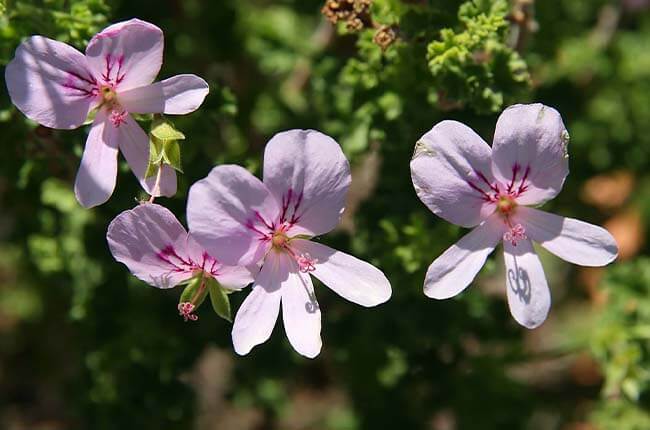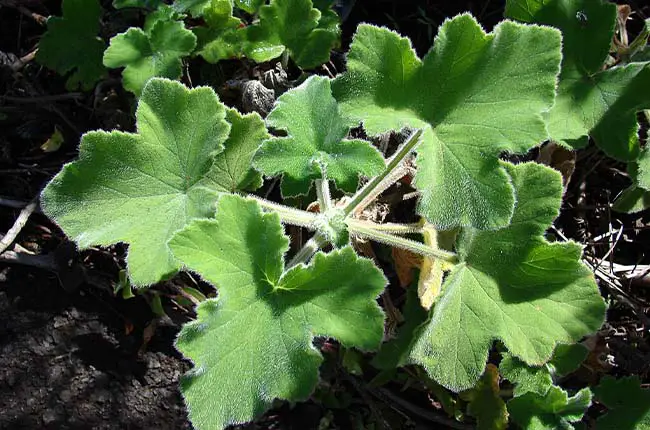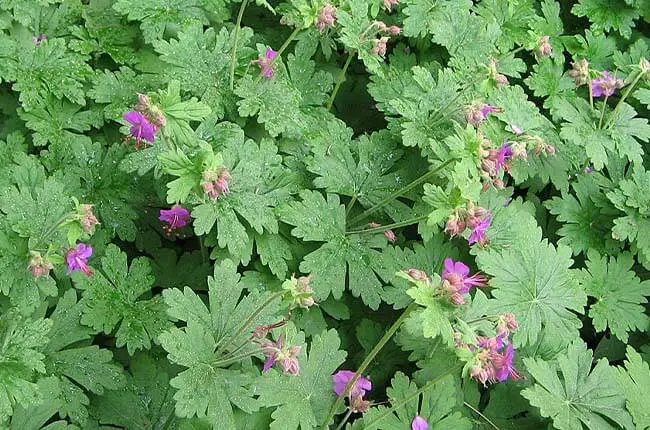Geraniums are popular ornamental plants grown for their attractive foliage and flowers. Apart from attracting pollinators, they have another valuable attribute that is often ignored.
Geraniums are an excellent natural insect repellant against pests, keeping them from laying eggs and even fumigating them.
In this article, we will explain how this attractive plant can play an important role in pest control, the best varieties, and how to use them to keep away bugs.
What pests do geraniums repel?
Geraniums are known to repel a variety of pests, including common ones such as ants, spider mites, aphids, Japanese beetles, thrips, cockroaches beetles, mosquitoes, and whiteflies.
These plants can also deter some larger pests like deer and rabbits.
They may not be as effective against slugs, snails, and worms, but geraniums can still provide some level of protection against these garden pests.
How do geraniums repel insects?
Geraniums can repel pests in various ways.
They possess certain essential oils such as citronellol and a compound called geraniol that can act as natural repellents against various pests.
When a pest lands on the plant, it encounters these oils and either gets repelled by their strong aroma or the oils physically block the insect’s ability to eat the plant. Additionally, some of these oils have been found to disrupt the lifecycle of certain insects, acting as growth inhibitors and preventing pests from maturing or reproducing.
For example, a study found that geranium oil can repel flies at a 1% concentration and have a lethal effect at concentrations ranging from 2.5% to 3% (Saraiva et al., 2020).
The oil can also repel sweet potato whiteflies, also known as “Bemisia tabaci biotype B”, keep them from laying eggs, and even fumigate them (Baldin et al., 2015).
Scented geraniums, which come in a range of fragrances, can also deter various types of pests with their strong scent by masking the presence of other plants, making it harder for pests to find their target.
Which types of geraniums can repel bugs?
Belonging to the genus Pelargonium, many scented geranium varieties have natural repellent effects on pests despite having varying levels of effectiveness. Here are a few examples:
1. Mosquito plant (Pelargonium graveolens or Pelargonium citrosum)
Also known as the Mosquito Plant or the Citronella Geranium, this variety has a strong citronella scent and is commonly believed to repel mosquitoes. They contain citronella oil, which is a natural ingredient often found in insect repellents.

(Mokkie, CC BY-SA 4.0, via Wikimedia Commons)
2. Lemon-scented geranium (Pelargonium crispum)
This variety has small white flowers that are typically white or pale lilac with delicate purple markings. When crushed, the finely crinkled leaves emit a strong lemon fragrance that can deter a variety of pests, including mosquitoes and leafhoppers.

(Photo by David J. Stang, CC BY-SA 4.0, via Wikimedia Commons)
3. Rose geranium (Pelargonium graveolens ‘Roseum’)
This variety releases a rosy fragrance when crushed that can deter ticks, mosquitoes, and even rabbits.
It can be identified by its rose-like flowers that are typically pink to almost lavender in color, with darker purple markings on the upper petals. It can grow up to 2-3 feet (60 – 90 cm) tall.

(Laitche, Public domain, via Wikimedia Commons)
4. Peppermint geranium (Pelargonium tomentosum)
Peppermint geraniums can be identified by their large, plush, and heart-shaped leaves which are covered in tiny hairs and can span up to 4 inches (10 cm) across. It produces small, white flowers that bloom in clusters during spring and early summer.
The leaves release a strong minty fragrance, which is reminiscent of peppermint when crushed. The strong peppermint smell can deter a variety of pests, including aphids and mosquitoes.

(Forest & Kim Starr, CC BY 3.0, via Wikimedia Commons)
5. Bigroot geranium (Geranium macrorrhizum)
This hardy geranium has semi-evergreen leaves that are rounded, deeply lobed, and slightly fuzzy. The leaves are a rich green color in the growing season and often take on hues of bronze or red in the fall, making this plant interesting year-round.
When crushed, the foliage emits a strong, spicy scent, which is one of the reasons why it is known to deter certain pests like deer and rabbits.
The flowers are small but showy, typically appearing in shades of pink or sometimes white.

(Meneerke bloem, CC BY-SA 4.0, via Wikimedia Commons)
6. Lavender geranium (Pelargonium lavandulaceum)
The leaves of this plant are notably slender and finely cut, with a grey-green color, resembling those of lavender plants.
The leaves emit a pleasing fragrance, which is similar to lavender when crushed or brushed against and is effective in repelling mosquitoes, flies, and moths.
The flowers are small and usually pink or lilac in color.
How to use geraniums to repel insects?
Geraniums can be used as a natural method for repelling pests in gardens, reducing the need for chemical pesticides and promoting a healthier ecosystem.
Companion planting
Geraniums can be used in companion planting in borders or alongside vulnerable plants.
They are particularly effective when planted alongside vegetables, such as tomatoes, and near members of the allium family (like onions, garlic, and leeks), to deter squash bugs, cabbage worms, and other common garden pests.
It must be noted that the potency of these plants can vary depending on growing conditions. Plants grown in full sun often produce more essential oils and have stronger scents, making them potentially more effective as pest deterrents.
Apart from their pest-repelling potential, using geraniums as companion plants can attract beneficial insects like bees, ladybugs, and lacewings, which can help keep harmful pests at bay.
However, simply having geraniums in your garden doesn’t mean that it will necessarily protect the garden from pests, as the pest-repellant chemical isn’t released into the air in large enough quantities to be an effective repellent on its own.
Geranium essential oil blend
Using a geranium essential oil blend in localized areas can provide a concentrated and more effective effect against pests.
Here’s a simple recipe for a homemade insect repellent using geranium oil at 1% concentration:
- 99 ml of base/carrier oil or distilled water. Carrier oils could be something like jojoba oil, sweet almond oil, or grapeseed oil, all of which have a mild scent that won’t overpower the geranium.
- 1 ml of geranium essential oil (this is approximately 20 drops for most essential oils, but it can vary slightly depending on the specific dropper used).
Stir or shake well to ensure the essential oil is fully mixed with the carrier/base. Pour the mixture into a spray bottle for easy application. Before each use, shake the bottle well to ensure the mixture is well combined.
How to avoid repelling beneficial insects?
Geranium oil may not differentiate between pests and beneficial insects. Its application could potentially repel or harm both pests and helpful pollinators such as bees and butterflies, as well as predatory insects that control pests.
To minimize the impact on beneficial insects, consider these strategies:
– Targeted application: Apply your homemade repellent only to specific areas where you tend to have issues with insects, like an outdoor seating area or a certain room in your house. Avoid broadly spraying the repellent across your garden or yard.
– Timing: Many beneficial insects are most active during the day. If the insects you want to repel are more active at dusk or dawn, consider applying the repellent during those times.
– Plant geraniums instead: Instead of using geranium oil as a pest deterrent, consider planting geranium flowers in your garden. While the scent can still deter certain pests, it may be less likely to affect beneficial insects compared to an oil applied directly. Plus, some types of geraniums are attractive to bees and other pollinators.
– Provide insect habitats: You can also encourage beneficial insects by providing suitable habitats for them in your garden. This can be anything from a small pile of rocks for beetles to a shallow dish of water for bees.
Remember that each insect species may respond differently to geranium oil and other repellents. If you’re seeing a negative impact on beneficial insects, you may need to adjust your approach or consider other methods of pest control. Always be mindful of your local ecosystem and aim to minimize harm.
Final words
While geraniums may help deter some pests in the garden, they should not be relied upon as a sole method of pest control.
It’s also worth noting that different pests may react differently to these plants. Some pests might be repelled by them, while others may not be affected.
Happy gardening!
Related
Top 51 Flowers That Pollinators Love: Ranked by Popularity
22 Plants For Your Bee-Free Garden
References
Baldin, E.L.L., Aguiar, G.P., Fanela, T.L.M. et al. (2015). Bioactivity of Pelargonium graveolens essential oil and related monoterpenoids against sweet potato whitefly, Bemisia tabaci biotype B. J Pest Sci 88, 191–199. https://doi.org/10.1007/s10340-014-0580-8
Saraiva, L.C., de Matos, A.F.I.M., Cossetin, L.F. et al. Insecticidal and repellent activity of geranium essential oil against Musca domestica and Lucilia cuprina. Int J Trop Insect Sci 40, 1093–1098 (2020). https://doi.org/10.1007/s42690-020-00137-4
Credits of featured photo: Eric Hunt, CC BY-SA 2.5, via Wikimedia Commons
- Keiki Paste vs Rooting Hormone:What’s the difference? - February 4, 2024
- Top 10 Orchid Fertilizers: A Comprehensive Review (2024) - February 2, 2024
- Top 8 Soil Inoculants For Stronger Plants (2024) - February 1, 2024


